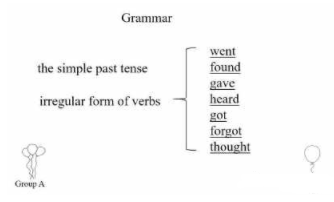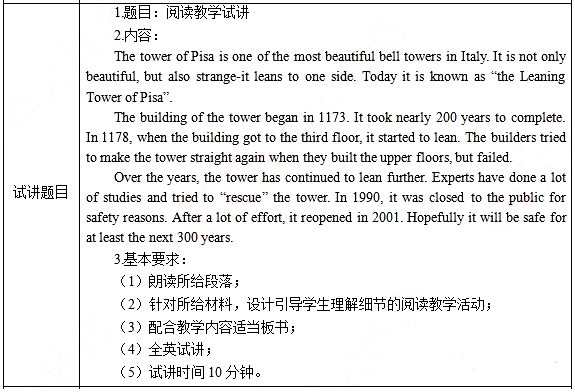2.内容:
One day, Ali Baba went to a cave and said,“Open, Sesame!" He found silk and gold inside the cave. He gave his wife some gold. His brother heard about the gold so Ali Baba gave him some, too. But the brother went to the cave and got some gold for himself. Unfortunately, he forgot the word “Sesame”“How do I get out of this cave?” he thought.
3.基本要求:
(1)朗读所给段落;
(2)配合教学内容适当板书;
(3)针对所给材料的划线部分,设计讲解该语法项目的教学活动;
(4)用英文试讲;
(5)试讲时间:10分钟。
Ⅰ.Lead-in
greetings.
Ask students to talk about their favorite stories.
II. Presentation
1. Show the picture of Ali Baba and invite them to guess “who is he”.
2. Students read the passage and get the main idea of this passage.
3. Students pay attention to the underlined words and discuss their similarities.
4. The teacher stresses the difficult in this grammar: the spelling of irregular form of verbs.
III. Practice
1. Pair work: Students work in pairs to find the mistakes in the sentences and try to correct them.
2. Students try to make a sentence with the irregular form of verbs to express something in the past.
IV. Production
The school will hold a speech competition. In the speech, students need to introduce their own stories. Now students work in groups to share the stories of themselves in the past, then share with the class. The best ones will gain the chance to attend the competition. Pay attention to the usage of verbs.
V. Summary
Students summarize the grammar learnt today .
VI. Homework
Students surf the Internet for more information about the simple past tense and try to use it correctly.
Blackboard Design:

2.内容:
We have four seasons in a year. They are: spring, summer,autumn and winter.
Spring is the loveliest season in the year. In this season,flowers bloom and birds sing. The world is full of life. The weather is warm and the swallows begin to come back to live with us again. Poets, descibe spring as s season full of hope.
Summer is the welcomest season to choolchildren. They have a long summer vacation. They may go to swim and play. They can go to seaside or go camping in mountains.
Autumn is a good season for picnics and games. In this season, leaves begin to fall and flowers begin to wither away.
This is why some people say that autumnis a season of sadness and loneliness, But| don' t think it is true. It is the season for harvests. The world is full of laughing and singing.
Winter is cold. In some nothern countries, snow begins to fall and most people have to stay indoors. But in tropical countries, the weather is still warm and the people go out of doors, as usual. When winter slowly passes, a new year will be borm.
3.基本要求:
(1)请设计一节阅读课;
(2)全英文授课;
(3)授课时间约10分钟;
(4)学生掌握不同季节的特征。
I. Lead-in
1. Greeting.
2. Teacher asks some questions about the four seasons:
How many seasons in one year? Which season do you like best?
II. Pre-reading
Prediction.
Students predict the main idea about the passage.
Ⅲ While-reading
Skimming:
Ask students to read the passage quickly and answer the main idea.
Scanning:
Students read the passage again and answer the following questions.
(1) Which season is the loveliest season and why?
(2) Which season is the most welcome season to choolchildren and why?
(3) Why does the author say he doesn't think autumn is the season of sadness and loneliness?
(4)In difterent places, what do peple do to have winter?
IV. Post-reading
Students should read these passage with feeling,and then invite some students to show it.
V. Summary
Students summarize what they have learned in this lesson.
VI. Homework
Students should write a short passage about their favourite season.
Blackboard design:略
2.内容:
End of the Year Party
l want you to remember the rules for school parties.Don' t wear jeans! lf you wear jeans, we won’t let you in.
Don ' t bring food to the party. If you do,the teachers will take it away.
Don' t leave the gym during the party.If you do, the teachers will call your parents.
Don ' t run or shout at the party. lf you do, you’ll have to leave.
Please bring your ID card. If you don't have your IDcard, you can't go to the party.
3.基本要求:
(1)配合教学内容适当的板书;
(2)并对当中的语法进行讲解;
(3)试讲时间:约10分钟;
(4)全英文试讲。
Free talk: show some picture about some behaviors in library ,and ask them these behaviors are right or wrong. if it's wrong and teacher can use Don‘t
Step 2 Presentation
(1) teacher show the whole pictures about the party and ask them to answer whether is correct.(For instance, if the behavior is wrong ,students should use the structure of"Don’t--lIf you… will/won’t…”)
(2) give students the whole text .Students pick out the sentences with the structure of"Don' t---If you--- will/won' t…”are, and underline them.
(3) Students work in pairs to paraphrase the sesentences and try to undersiand the meaning of“Don't…if you… will/won't…”.
(4) Tht teacher explains the usage and important points of the negative form of imperative sentence and draw the conclusion about the structure “Don't…-lf you… will/won't…”.
step 3 Practice
(1) Using structures
Show exercises on the ppt
Answer the following questions using the structure"Don'…”.
What' s the rule when you watch a movie?
What kind of notice signs can you find in school?Do you know some school rules on our campus?
(2) Make sentences
Make some sentences with the structure" lf you do …, …. will/won't…”.
Step 4 Practise
The teacher give a topic about the class rules: the necessity of class rule. (For instance: Do you think it is necessary for us to make some rules in our class?) Students can make a list of their class rules and discuss their opinions with their partner according tothe grammar structure “Don’t….”.
Step 5 Summary
Students summarize what they have learned today and the important points of the usage of the structurc“Don’t…lf you… will/won't…”. The teacher stressesthe importance of obeying the rules in different places.
step 6 Homework
Make rules for themselves using " Don 't… lf you…will/won' t-….”.They can share it next class.
Blackboard design:略

Teaching aims
Students can have a better understanding of the reading material about The Leaning Tower of Pisa.
Students will learn some useful expressions to introduce places of interest.
Students are able to use different basic reading strategies like grasping details correctly in their reading process.
Students will be interested in traveling more places of interest all over the world.
Key and difficult points
Key point
To understand the content of the passage and know how to introduce the place of interest.
Difficult point
To grasp the reading strategy and raise their interest in traveling more places of interest all over the world.
Teaching procedures
Step 1: Warming-up
1. Greet students by using different languages.
2. Sing a song named You and Me together with the class:
You and me, from one world.
We are family.
Travel one dream, a thousand miles.
Meeting in Beijing.
Invite students to introduce the background of this song and share some information with students that every four year countries all over the world will take part in the Olympic Games and ask students whether they know the amount of countries in the world and whether they can name some.
Step 2: Pre-reading
Show students pictures of the Roman Colosseum and Venice, ask students to describe them and then ask them whether they know where they are and which country they are in.
Step 3: While-reading
1. Extensive reading
Ask students to read the passage quickly for the first time and try to figure out what the passage is mainly about. Then invite one student to share the answer: the main idea is the introduction of The Leaning Tower of Pisa.
2. Intensive reading
Ask students to read the passage for the second time and at this time, let them pay attention to some key numbers which refer to years. Then try to make a timeline according to the passage.
Then invite some students to come to the stage to show their answers on the blackboard.
3. Ask students to read after the teacher to imitate the intonation and pronunciation.
Step 4: Post-reading
Story-sharing time
Ask students to work in groups of 4 and 8 minutes will be given to them to share their own traveling experiences, and introduce more places of interest they know or they have traveled to their group members. When the time is over, invite 2 groups at random to share and give proper evaluations.
Step 5: Summary and Homework
Summary: invite the monitor to make a summary and also share his own opinions on the topic. Then remind students to protect the environment wherever they travel.
Homework: ask students to find more information about places of interest and then choose one they like best to recommend to the doctors and nurses who work hard during the epidemic.
Blackboard design略
2.内容:
(Daniel is hosting the school radio show this week. He is interviewing Jenny, a Grade 9 student, who has recently visited the UK.)
Daniel: Hi, everyone. Today we’ve invited Jenny to talk about manners in the UK. What’s the proper way to greet people there, Jenny?
Jenny: Well, British people say “hello” or “nice to meet you” and shake your hand when they meet you for the first time.
Daniel: Do they greet people with a kiss?
Jenny: No. British people only greet relatives or close friends with a kiss.
Daniel: How do people start a conversation?
Jenny: They talk about the weather, holidays, music, books or something else. But please avoid subjects like age, weight or money.
3.基本要求:
(1)有感情地朗读所给材料;
(2)根据该段落的内容,设计相应的阅读教学活动;
(3)全英授课。
Teaching aims:
Knowledge aim:
Students can get to know the content of this passage.
Ability aim:
Students can improve their reading and speaking abilities.
Emotional aims:
Students will improve their awareness of being polite.
Students can arouse their interest and confidence of English learning.
Key and difficult point:
Key point:
The improvement of oral English and understanding of this passage.
Difficult point:
How to cultivate their awareness of using polite manners and put it into practice.
Teaching procedure:
Step 1: Warming-up
1. Greetings.
2. Show some pictures about different greeting manners around the world.
3. Ask students how much they know about it and lead out the topic.
Step 2: Pre-reading
1. Introduce some background information related to greeting manners.
2. Show a picture of two people making interview on the screen. Ask students to predict what will happen in the following dialogue according to it.
Step 3: While-reading
Global reading:
Ask students: “Where did Jenny visit?” and “How do the British people usually greet?”
Detailed reading:
Ask students: “When do they greet with a kiss?” and “What should be avoided when they start a conversation?”
Step 4: Post-reading
Role-play:
Two students are in a group. One student acts as an interviewer and one student is an interviewee. Give them 5 minutes to make a dialogue about manners in China based on the knowledge they’ve learned today.
Step 5: Summary and Homework
Summary: ask a student to conclude the content of the lesson and summarize with the whole class.
Homework: finish the exercise on the book and surf more details about greeting manners in western countries.
Blackboard design:
Good Manners
Where? -UK
How? -Say “hello” or “nice to meet you”
When? -Only with relatives or close friends
What? -Avoid the subjects like age, weight and money.



